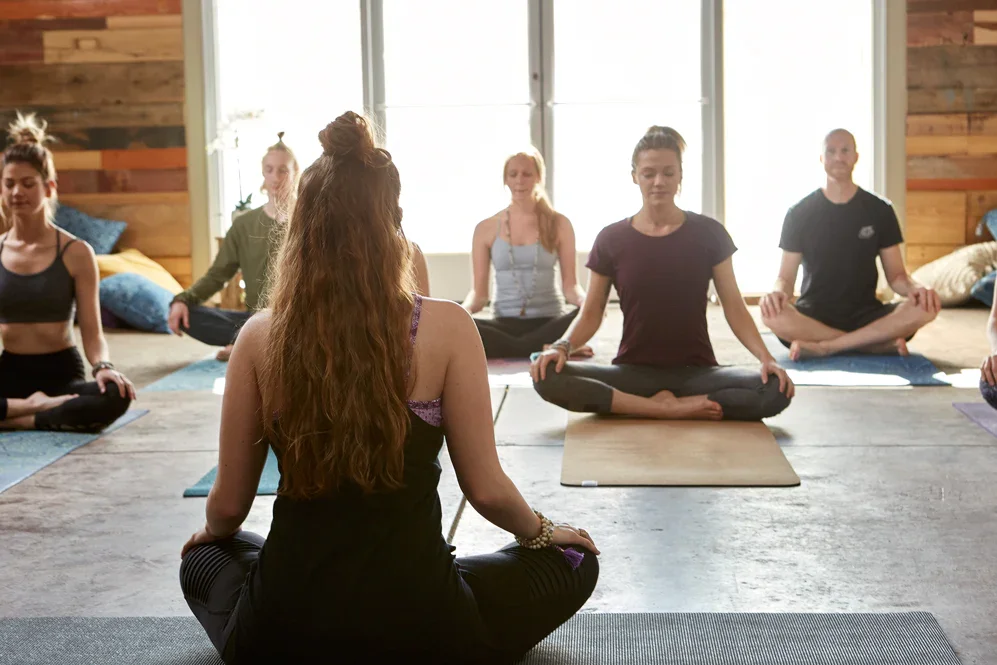7 TEACHING TIPS EVERY YOGA TEACHER SHOULD KNOW:BY WWW.GAIAM.COM

1. KEEP YOURSELF BALANCED
As a yoga teacher, remaining balanced and patient emotionally, physically, and mentally is essential. This allows your students to rely on your teachings consistently from week to week, day to day, and vice versa. While we aim to find balance in certain postures on the mat, there is a kind of balance that goes beyond your asana practice. Emotional and mental balance helps you stay positive, sensitive, capable of forming a deep connection to yourself and others. It allows you to stay present in the moment and feel more centered. It also greatly impacts your teaching skills as you gain more experience, as it drives you towards being more humble and approachable.
2. DEMONSTRATE AND EXPLAIN IN DETAIL
Successful yoga teachers design a comprehensive class by building thoughtful sequences and delivering them clearly to their students. This doesn’t pertain to just the asanas, but corresponding breathwork and the anatomical breakdown of the body and message behind each pose as well. Additionally, always take every opportunity to be present in your teaching, be it watching your students and offering adjustments, giving anatomical cues, or opening up about experiences relevant to your theme, etc.
3. INCORPORATE THE ART OF BREATHING
Breath is the most important aspect of any yoga practice. By bringing conscious awareness to the breath, we activate an internal, deep-level change and bring balance to the body and mind. A conscious breathing practice, otherwise known as Pranayama, should be the key part of your class that’s incorporated during both the meditation and asana segments. By introducing this to your students, you can help them learn pranayama techniques and encourage them to practice it off the mat. This will ultimately help your students improve concentration, build focus, and enhances their asana practice.
4. DESIGN YOUR CLASS AROUND YOUR STUDENTS
Even after completing your YTT, there may be moments as a new teacher where a certain type of student walks into your class you don’t expect. This could include a pregnant woman, a yoga beginner, someone with a specific injury, etc. Investing time into taking workshops or continued education programs will help you instruct more confidently when this individual walks into your studio. These classes or programs will help you know what adjustments or modifications are ideal to offer in each unique situation. They will also help you to design a well-rounded sequence that includes various poses for flexibility, balance, stress-relief, muscle-strengthening, etc.This kind of sequence should include a blend of warm-up poses, standing poses, twists, inversions, backbends, forward-bending poses, closing postures, and of course, savasana. Also, consider the students experience level and build accordingly. Then don’t forget to add a dash of your own unique style, whether it be through music or sharing a personal story relative to your theme.
5. ENGAGE IN EFFORTLESS COMMUNICATION
Teaching yoga requires you to be a great communicator. It’s important to think about the ways you address your class, whether it be speaking in a tone that everyone can hear, or inunciating your words so you are well understood. This can take practice and doesn’t always happen overnight, so practice teaching to your friends, family or coworkers! Eventually, you will get to a place where your communication seems unadorned and effortless.
6. COMMIT FULLY TO YOUR OWN PRACTICE
Self-practice is something that distinguishes a good teacher from a great one. To hold space for an amazing yoga class, it’s crucial to invest time in your own practice. Inner work and committing fully to your own practice encourages you to continuously grow in your teaching. The more you show integrity in your yoga journey, the more authentic you will be to your students. Self-practice helps you connect internally and believe in yourself fully. And remember, people will only trust and believe in you once you start trusting yourself, and giving time to your own practice is the best way to achieve this level of self-trust.
7. ALWAYS KEEP LEARNING AND CONTINUE TO EVOLVE
Life never stops teaching us, on and off the mat. As a yoga teacher, do not stop being a student, regardless of how experienced you’ve become. To bring excitement to your practice and to be more innovative with your teachings, continue your education, whether it be through workshops, retreats, or trainings. Yoga teachers have the ability to be the guiding light for their students by introducing them to self-love, self-awareness and the mind-body connection. Follow these tips and your teaching will be one that resonates with students for years to come.